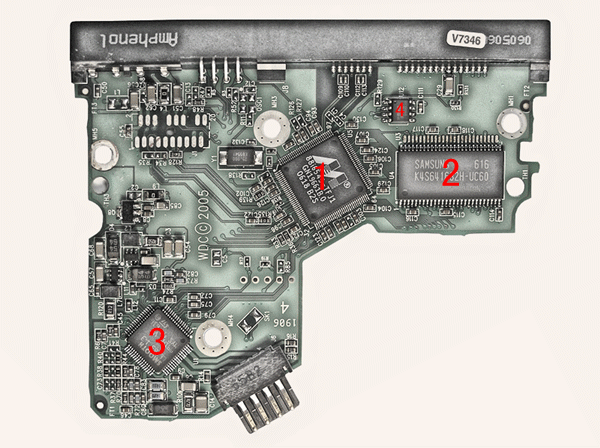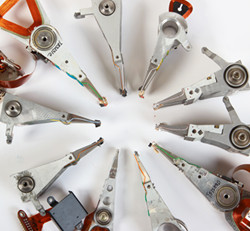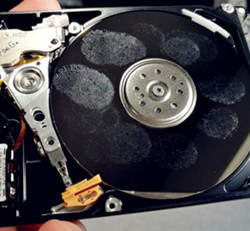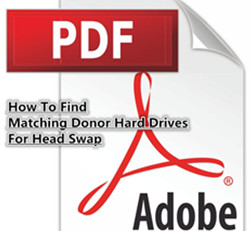Tuesday, April 17, 2012
How To Fix Damaged ATA Module For WD Black I Series
ATA Module Overview
1,It’s used to get into the factory mode.
2,The LBA value becomes 0 when it’s damaged.
3,ROM and ATA module must be compatible with each other.
How To Fix Damaged ATA Module For WD Black I Series
1.Find a compatible drive (same model number and pcb number)
2.Backup the ATA module from donor drive.
3.Swap the pcb and upload the ATA module.
4.Power off and on.
About are just general hdd repair tips, more hdd repair tips are available in our data recovery books or you may read them in other data recovery articles.
Monday, January 30, 2012
How To Fix Damaged Hard Drives With Jammed Spindle Motors
When we received damaged hard drives with stuck or jammed motors, we usually consider using some kind of hdd repair hardware to disassemble the hard drives, remove the heads carefully and then remove the platters of the patient drives to a donor hard drive. Well, this is not easy data recovery work especially when there're multiple platters of over 2 with dumpers between the platters.
We know there're some data recovery tools manufacturers claiming to be able to swap multiple platters with dumpers but few of them can do it with good result and even some of them caused second damage or permanent loss to our customers' data which disappointed and annoyed us a lot. There's one data recovery tools supplier declared their one-by-one platter exchange for jammed-motor drives with dumpers but it seems only their own clean room data recovery engineers are able to use that data recovery technology successfully but none of the rest. Maybe a thousand times' try will make it.
So what to do to increase our data recovery success rate while the traditional data recovery technology for jammed-motor drives failed?
Thanks to HDDsurgery, we got the spindle replacement tool. It's innovatively changing the way of clean room data recovery. It's to replace the jammed spindle instead of head and platter replacement which will be kept in place and alignment for successful data recovery. However, this tool is working so far for a limited drive families: Seagate 7200.11 and 7200.10 and support the following drive models: Read more here on data recovery magazine
Monday, January 16, 2012
Data Recovery Secrets
Data recovery is a closed field and each person who works in this field has given their time and money to find answer to problems. They are not so willing to share these secrets with other after investing thousands of dollars and hours to find an answer to this problem. I feel the Internet has made data recovery look very simple and anyone can do this job. Yes you will have a successful data recovery department in your work area but it will take time to do this work. Nobody can teach you all there is to know in a few weeks or even a few months. This takes years of training and working in this field.
Even data recovery experts encounter problems each day in their work and they still are searching for answers and trying to find a way to fix some of these problems. Sometimes the problem is not related to their knowledge it is related to the tools and not being able to handle the problems they have encountered. The tools are updated regularly but it is almost impossible to have a solution to a problem we have never seen before.
There are also many data recovery training courses telling you to create you to be data recovery experts, do you trust them? No! We create ourselves data recovery experts! Good data recovery training courses give you the right way and right methods and right materials and right truth.
Sunday, January 15, 2012
Look Into Chips on Hard Drive PCB
The first chip: The heart chip of one PCB
The heart of PCB is the biggest chip in the middle called Micro Controller Unit or MCU. On modern HDDs MCU usually consists of Central Processor Unit or CPU which makes all calculations and Read/Write channel - special unit which converts analog signals from heads into digital information during read process and encodes digital information into analog signals when drive needs to write. MCU also has IO ports to control everything on PCB and transmit data through SATA interface.
Chip 2: The Memory Chip
The Memory chip is DDR SDRAM memory type chip. Size of the memory defines size of the cache of HDD. Usually you find the size of memory in datasheet of the HDD, theoretically it means HDD has that size of cache but it's not quite true. Because memory logically divided on buffer or cache memory and firmware memory. CPU eats some memory to store some firmware modules and as far as we know only Hitachi/IBM drives show real cache size in data sheets for the other drives you can just guess how big is the real cache size.
Chip 3: VCM(Voice Coil Motor controller) controller chip
This chip is the most power consumption chip on PCB. It controls spindle motor rotation and heads movements. The core of VCM controller can stand working temperature of 100C/212F.
Chip 4: Flash ROM Chip
Flash ROM chip stores part of the drive's firmware. When you apply power on a drive, MCU chip reads content of the flash chip into the memory and starts the code. Without such code the drive wouldn't even spin up. Sometimes there is no flash chip on PCB that means content of the flash located inside MCU.
A million thanks to Data Recovery Salon for sharing such an excellent platform for sharing data recovery knowledge here. I will support you by sharing more of mine.
Samsung Hot Swap Guide
The following are the reference steps for Samsung hotswap:
Step 1: Power on donor. Run the hdd repair tool which support hotswap. Wait until initialization will complete,then put drive to sleep mode;(You can use pc3000 udma)
Step 2: Unscrew the PCB from donor and install it on patient drive. Screw the screws back. And perform recalibration;
Step 3: Wait until the drive will enter ready state, then read the modules from the drive except some "big capacity" log modules;
Step 4: Power off donor PCB and swap it on donor HDA;
Step 5: Write all necessary modules(Look the list below) from patient to donor drive .Then switch drive's Power off/on;
Step 6: Press Sleep and Swap the PCB from donor drive to patient HDA;
Step 7: Screw all the screws and do the recalibration. The patient drive is "hot-swapped", try to access the data on it.
Modules for those families V11P, VICTOR, PUMA, VICTORPLUS, VERNA, VERNALITE:
"UNITABLE"
"SLISTHDR" (except V11P & VICTOR)
"SLIST"
"TLIST"
"ALIST"
Modules for those families PALO, PANGO, VANGOPLUS, VELOCE, RUBICON, P80A, P80M, DELPHI, POSEIDON, CAESAR:
"06 CONFIG"
"10 SLISTHDR"
"11 SLIST"
"12 TLIST"
"13 ALIST"
"5D CONFIG2" (if it exist in modules table)
"62 ALISTHDR" (except PANGO, VANGOPLUS, VELOCE, RUBICON, P80A)
Modules for those TRIDENT, T166(S), STORM2(S166), TRIDENT3(S250):
"05 SRVTBL"
"06 CONFIG"
"0C ARCOTBL"
"0D GEO_TBL"
"10 SLISTHDR"
"11 SLIST"
"12 TLIST"
"13 ALIST"
"17 SRVTBL2"
"18 ARCOTBL2"
"62 ALISTHDR"
"6E 10SOFS"
"71 VFY_PATT"
"80 SCT_DATA"
"9B HSC_RST"
"9C FOD_NRRO"
"9D FOD_HSC"
"9E HSC_DT"
"9F HSC_RST"
"A0 FOD_NRRO"
"A1 FOD_HSC"
"A2 HSC_DT"
"A3 HSC_CYL"
"A4 IN_SITU"
"A7 FOD_HRLR"
"B3 AVSCAN"
For 2.5 Samsung Mango family
After all modules except "OVERLAY" were copied from patient to donor drive and a hot-swap was done - the drive come to ready state and the access to customer data was achieved.
We were using pc3000 UDMA with this method for Samsung hdd repair with high success rate. Read more data recovery tips or get more information about free data recovery tools and solutions on Data Recovery Salon.
Thursday, January 22, 2009
How To Avoid Making A Bad Situation of Your Hard Disk Even Worse

If you experience a hard drive crash, it doesn’t take much to make a bad situation even worse. In the event of a hard drive crash, in most instances, the data is completely recoverable at first. However, as part of human nature, we often try to avoid the high costs associated with hard drive data recovery in order to find some sort of “quick fix” to a very serious problem. In this report we will go over some of the symptoms of a hard drive crash and the things you can try in the event of a suspected hard drive crash, along with things you should avoid.
Friday, January 16, 2009
Donor Matching Parameters for Different Drive Brand
Maxtor PCBA Change:Model;PCBA number
Maxtor FW Change:Model;Code;The first 3 digits of SN
maxtor Head Change:Model;the 4 letters(X,X,X,X)
Seagate Hard Drive:
Seagate PCBA Change:Model;FW Edition;If the HDD has ROM chipset:Change ROM data
Seagate FW Change:Model;FW Edition;The first 3 digits of SN
Seagate Head Change:Model
WD Hard Drives:
WD PCBA Change:Model;FW edition;the first 3 digits of SN,Motor number
WD FW Change:Silver1:Model,FW Edition;CapacitySilver2/Black1/2:Model,FW Edition;Capacity,Motor Number;
WD Head Change:Model;The first 3 digits of DCM;Motor Number
Hitachi Hard Drive:
HITACHI FW Change:Use Original FW in SA-C to recover FW in SA-A and SA-B
HITACHI PCBA Change:HDD series and the first 2 lines identification label same
HITACHI Head Change:same model
More Infromation, please find in our FAQ system.
Hard Disk Clicking Causes

In Data recovery field, we often meet with problem of hard drive clicking, sometimes described as a repeating tick tick tick type of ticking sound. If you hear this kind of Clicking noise, This means your hard drive suffers from physical damage. If you use a S.M.A.R.T enabled disk, you may see a warning of a imminent disk failure when you power up your computer. you’d better turn off your computer immediately and find some professional persons who can help you. Otherwise, the data in your computer is at the risk of Loss.
The following can be the possible reasons for these clicking noises:
1, Bad sectors
Bad sectors are areas of the hard disk that become unreadable. The clicking sound happens when the head attempts to read from the same area of disk multiple times due to failed attempts. This can also occur when the head is unable to calibrate with the media servo tracks due to the gradual weakening of the magnetic domains on the platter that causes the drive to reset continuously. If the conditions of the disk is not too bad, a standard process is to perform a disk surface scan. This helps to mark all bad sectors and prevent your system from writing new data on the damaged areas of the disk.
2, Head Crash
This is a physical damage of the disk platter when the head of a hard disk scratches the surface of the disk. The grinding sound is therefore observed when this occurs. Firstly, turn off your computer and do not attempt to power it up. Consult a data recovery firm immediately and avoid dismantling the disk to repair the problem yourself. Operating without the correct tools and a clean environment can result in further extensive damage which complicates the recovery process.
3, Mechanical Faults
Sometimes these sounds can be a result of a defective spindle, Read Write head or loose omponents. If you are still able to access data on the disk, you are strongly advised to backup all your data immediately. Your disk is close to demise. If your disk stops spinning after a period of clicking sound, you may wish to send your disk to a reputable data recovery firm to recover your data.
4, Virtual Memory Paging
When your physical memory is full, the drive may perform numerous virtual memory paging at the same time maintaining the system’s operation. This will result in excessive disk activity. To deal with this problem you can increase the physical memory by adding more RAM into your computer or use a secondary hard disk to contain the swap files.
Clicking sound and whirring sound
Whirring sound happens in the hard disk drive when it searches for a file which is heavily fragmented. This is caused by the spinning platters as the read-write heads zoom back and forth to access the sectors where the data is stored. It is important to distinguish the whirling sound from the clicking sound. This whirring sound can be reduced by periodically defragmenting your hard drive. Defragmenting reorganizes the scattered data on the hard drive to make files and programs run faster. It relocates the commonly accessed files to the beginning of the hard disk where data can load at a faster rate.









